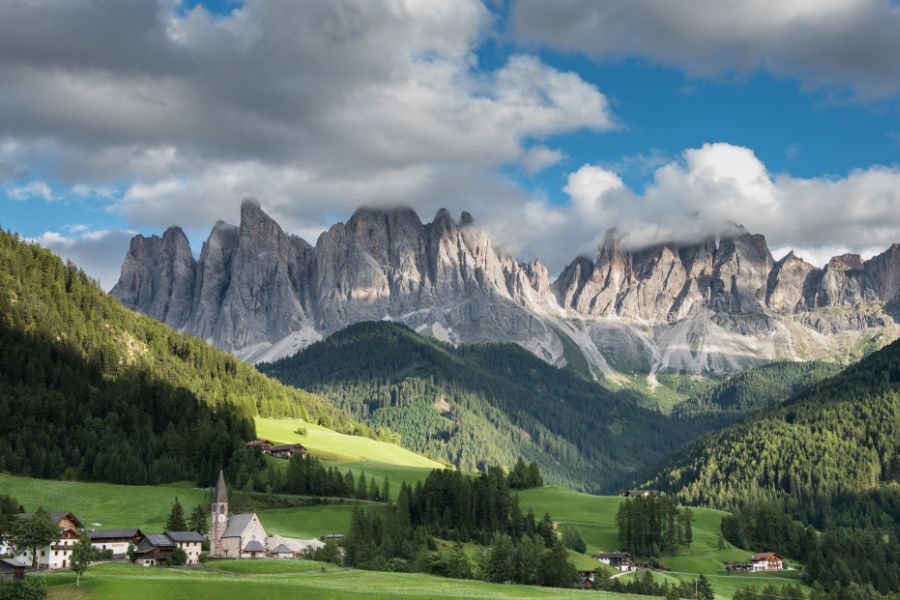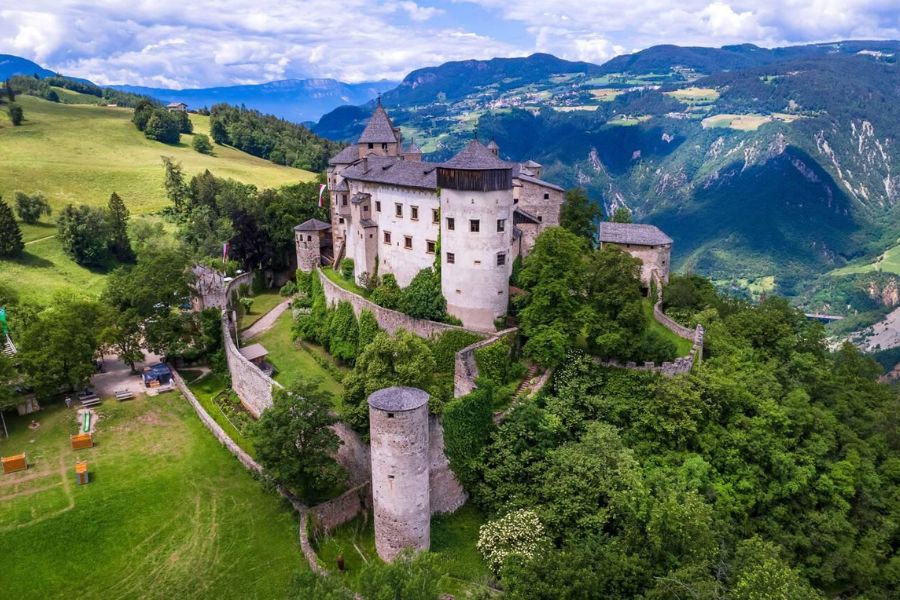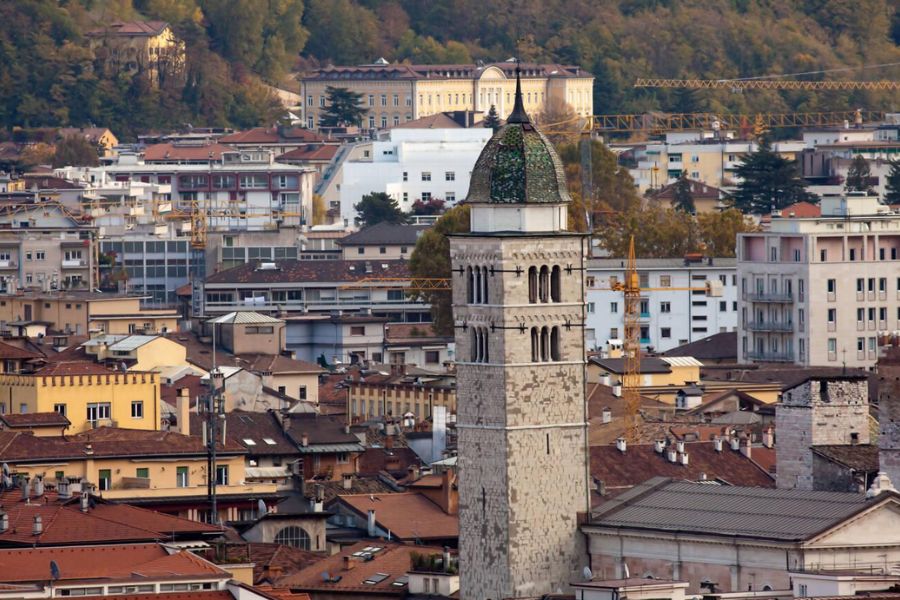Tucked between the majestic Dolomites and the Adige Valley, Trento captured my heart the moment I stepped into its historic center. This charming Italian city perfectly blends Renaissance elegance with Alpine character, creating a unique destination often overlooked by travelers rushing between Venice and Milan.
Walking through Trento’s medieval streets feels like discovering a secret treasure where Italian culture meets mountain traditions. Visitors get a double dose of authentic Italian experiences without the crowds of more famous cities.
I spent my morning wandering through Piazza Duomo, admiring the pastel-colored buildings and intricate frescoes that tell stories of Trento’s rich past. The Renaissance influence is unmistakable here, from the ornate facades to the historic palaces. Yet just a glance upward reveals the snow-capped mountains that remind you this isn’t typical Italian terrain—it’s an Alpine wonderland with a distinctly Italian soul.

What makes Trento truly special is how it serves as a gateway to adventure. After exploring Gothic architecture and Renaissance art in the morning, I found myself sipping local Trentodoc sparkling wine in the afternoon, gazing at the Dolomite peaks that frame this compact city. For travelers seeking both cultural immersion and natural beauty, Trento offers the perfect balance without requiring you to choose between the two.
The Historic Charm of Trento
Trento captivates visitors with its perfect blend of Italian Renaissance elegance and Alpine influence. Walking through its historic center feels like stepping into a living museum where centuries-old architecture tells stories of powerful bishops, Roman settlements, and artistic innovation.

Renaissance Splendor in Architecture
The heart of Trento’s charm lies in Piazza del Duomo, where the magnificent Cathedral of San Vigilio stands as a testament to the city’s religious importance. I was struck by its imposing Romanesque-Gothic facade when I first visited. The cathedral houses remarkable frescoes that depict the Council of Trent, a pivotal event in Catholic history.
Nearby, Castello del Buonconsiglio dominates the cityscape with its imposing walls. This former residence of prince-bishops features a stunning mix of medieval fortifications and Renaissance elegance. I spent hours exploring its Torre dell’Aquila, home to the famous “Cycle of the Months” frescoes that offer a rare glimpse into 15th-century daily life.
The Renaissance palaces lining the streets showcase beautiful painted facades and ornate balconies. Many buildings still bear traces of Roman influence, reminding visitors of Trento’s ancient origins.
Trento’s Cultural Tapestry
Beyond architecture, Trento’s cultural heritage weaves a rich tapestry of Alpine and Italian traditions. The city’s museums expertly showcase this blend, with MUSE (Science Museum) offering innovative exhibits on Alpine ecology alongside historical artifacts.

I loved discovering how Trento’s position along historic trade routes shaped its unique identity. The city absorbed cultural influences from both Germanic lands to the north and Mediterranean regions to the south, creating something distinctly “Trentino.”
Religious art plays a significant role in the city’s cultural landscape. Churches like Santa Maria Maggiore contain masterpieces that reflect the city’s importance during the Counter-Reformation period. The church itself hosted sessions of the famous Council of Trent that reshaped Western Christianity.
Local festivals throughout the year celebrate Trento’s heritage with parades, folk music, and traditional cuisine that combines Italian flavors with Alpine ingredients. These celebrations keep ancient traditions alive while connecting visitors to the authentic soul of this fascinating Alpine city.
Dramatic Landscapes of the Alpine Region
Trento sits at the gateway to some of Italy’s most breathtaking mountain scenery. The Alpine region surrounding this Renaissance city offers dramatic landscapes that contrast beautifully with the historic architecture found in town.
Journey Through the Dolomites
The Dolomites near Trento create an unforgettable backdrop with their jagged peaks and distinctive pale rock formations. I was stunned by the Five Towers (Cinque Torri), dramatic rock formations made of Dolomia that rise dramatically from the landscape.
A short chairlift ride to Scoiattoli offers panoramic views that are worth every penny. During my visit, early morning hikes provided the best lighting for photos, with the mountains glowing pink during the famous “alpenglow” at sunrise.

The region offers trails for every ability level. I found several well-marked paths with stunning viewpoints that didn’t require technical climbing gear. Mountain biking enthusiasts will discover a network of trails ranging from leisurely routes to challenging downhill tracks.
The Natural Majesty of South Tyrol
South Tyrol blends Italian and Germanic influences with spectacular Alpine scenery. The region features pristine valleys, crystal-clear mountain lakes, and charming villages nestled between towering peaks.
I discovered that South Tyrol’s microclimate creates unique growing conditions for vineyards that climb up steep mountainsides. The local wines, particularly the crisp white Gewürztraminer, perfectly complement traditional Alpine cuisine.
While Mont Blanc sits farther west, the mountains here share similar dramatic qualities. Hiking through flower-filled Alpine meadows in summer reveals a landscape transformed from the snow-covered winter wonderland.

The Adige Valley offers gentler terrain for cycling enthusiasts. I rented a bike in Trento and followed the riverside path, enjoying views of terraced vineyards against a backdrop of soaring mountain peaks.
Indulge in the Flavors of Trentino
Trento’s culinary scene perfectly blends northern Italian traditions with Alpine influences, creating a unique food culture that deserves exploration as much as the city’s Renaissance architecture.
Italian Cuisine at Its Alpine Best
The food in Trento surprised me with its perfect balance of hearty mountain fare and refined Italian cooking. Local restaurants serve canederli, bread dumplings often flavored with speck (smoked ham) or cheese, floating in rich broths.
I discovered that strangolapreti, spinach and bread gnocchi whose name means “priest stranglers,” tells a fascinating story of the region’s history. These delicious dumplings are typically served with sage-infused butter.
Polenta here isn’t just a side dish but often the star, topped with local cheeses like Puzzone di Moena or wild game ragù. The alpine influence shows in dishes featuring mushrooms foraged from nearby mountains.

For dessert, try strudel—a reminder of Trentino’s historical Austrian connections. Many cafés in Piazza Duomo serve this pastry with a distinctly Italian twist.
The Tradition of Wine Tasting in the Mountains
Trentino’s vineyards benefit from the unique Alpine microclimate, producing crisp, aromatic wines unlike anywhere else in Italy. The region is famous for its sparkling wines made using the classic method, locally called Trentodoc.
I visited a small vineyard on the sunny slopes outside the city where the winemaker explained how the dramatic temperature shifts between day and night give their wines distinctive character. Ferrari, the region’s most famous producer, offers tours that showcase this process.
The indigenous Teroldego grape creates robust reds that perfectly complement local cuisine. During my visit, I paired a glass with a plate of local cheeses at a wine bar near Castello del Buonconsiglio.
Alto Adige wines are also featured prominently in Trento’s enotecas, with crisp Gewürztraminer and Müller-Thurgau reflecting the area’s Germanic influences. Many restaurants offer wine flights paired with small plates, allowing you to sample the region’s diversity.
Exploring Beyond Trento: Day Trips and Excursions
While Trento captivates with its Renaissance charm, the surrounding area offers breathtaking landscapes and cultural experiences worth exploring. Several stunning destinations are just a short drive or train ride away, making for perfect day trips.

The Serene Beauty of Northern Italian Towns
Bolzano, just an hour north of Trento, welcomes visitors with a unique blend of Italian and Austrian influences. I love wandering through its colorful medieval center and visiting the South Tyrol Museum of Archaeology, home to the famous Ötzi the Iceman.
Merano offers a more relaxed pace with its beautiful thermal baths and gardens. The town’s elegant promenades lined with Belle Époque buildings make for a pleasant afternoon stroll. Don’t miss the Gardens of Trauttmansdorff Castle, featuring plants from around the world.
For wine enthusiasts, the small towns along the South Tyrolean Wine Road provide wonderful tasting opportunities. Many vineyards offer tours where you can sample the region’s crisp white wines while enjoying mountain views.
Adventures in Bressanone and Beyond
Bressanone (Brixen) enchants visitors with its 10th-century cathedral and medieval architecture. I recommend taking a morning tour of the Bishop’s Palace with its stunning frescoes before enjoying lunch at one of the cozy restaurants in the main square.
The Dolomites are easily accessible from Bressanone. A chairlift ride to areas like the Five Towers offers dramatic mountain views without requiring difficult hiking. The rock formations here are truly spectacular, especially in the golden light of late afternoon.

For those willing to travel a bit farther, day trips to Venice (about 2.5 hours by train) or Milan (about 3 hours) are possible. While these cities deserve longer visits, even a quick trip lets you experience their iconic attractions before returning to Trento’s peaceful ambiance in the evening.
Unearthing History: Trento’s Museums and UNESCO Sites
Trento’s rich historical tapestry comes alive through its world-class museums and UNESCO-recognized heritage. The city offers an incredible journey from ancient civilizations to Renaissance grandeur.
A Journey Back in Time: From Etruscans to 16th Century
Walking through Trento’s museums feels like traveling through time. I was amazed by the extensive Etruscan collections that showcase intricate pottery and jewelry from this sophisticated pre-Roman civilization.
The archaeological museum houses remarkable Celtic artifacts that tell the story of these early Alpine settlers. Bronze weapons, intricate jewelry, and everyday items reveal their complex society that flourished in these mountains.
What truly captivated me was the seamless timeline the exhibits create. You can literally follow humanity’s journey from prehistoric times through Roman occupation to medieval Trento. Each display is thoughtfully arranged with informative yet easy-to-understand descriptions.
The UNESCO-recognized sites throughout the city complement these museum experiences perfectly. I recommend setting aside at least half a day to fully appreciate these historical treasures.
The Artistic Legacy of the Renaissance Era
Trento’s Renaissance art collections took my breath away. The Museum of Modern and Contemporary Art features stunning 15th and 16th-century masterpieces that showcase the region’s unique artistic style.
What makes Trento’s Renaissance art special is the blend of Italian and Germanic influences. You’ll notice this distinctive fusion in the:
- Vibrant frescoes adorning aristocratic mansions
- Religious paintings with unusual Alpine backgrounds
- Sculpture combining classical forms with northern European details
The city center itself serves as an open-air Renaissance museum. I spent hours admiring the sumptuous frescoed façades of noble homes. These colorful exterior decorations were a status symbol for wealthy families.

The cathedral houses some of the finest religious art from this period. Don’t miss the side chapels with their remarkable altarpieces showing biblical scenes against recognizable Trentino landscapes.
Practical Information for the Intrepid Traveler
Planning your Trento adventure requires some knowledge of where to stay, how to get around, and what to expect from the Alpine climate. I’ve gathered essential details to help you prepare for a smooth and enjoyable visit.
Accommodation and Transfer
I’ve found Trento offers diverse lodging options for every budget. The historic center features charming boutique hotels like Hotel Aquila D’Oro and Hotel America. At these hotels, you can wake up to Renaissance architecture outside your window. For budget travelers, Ostello di Trento provides clean, affordable accommodations within walking distance of major attractions.
Getting to Trento is surprisingly easy! The city sits on Italy’s main north-south railway line. This line connects Venice and Milan to Austria and Germany. From Milan, the train journey takes about 2.5 hours. For exploring South Tyrol and surrounding mountains, I recommend renting a car. However, the local bus system efficiently connects to nearby villages.

The city center is compact and walkable. So, comfortable shoes are all you need for daily explorations!
When to Visit and What to Pack
I’ve visited Trento across different seasons. Late spring (May-June) and early fall (September-October) offer the perfect balance of pleasant weather and smaller crowds. Summer brings vibrant festivals but also more tourists, while winter transforms the city into a charming Christmas destination with markets and Alpine snow.
The Alpine climate means temperature fluctuations, even in summer. I always pack lightweight layers. I also bring a waterproof jacket, comfortable walking shoes, sunscreen (the mountain sun is stronger than you think!), and a daypack for mountain excursions.
If visiting between December and February, bring proper winter gear. Temperatures can drop below freezing, especially in the mountains around South Tyrol. The upside? You’ll experience authentic Italian Alpine culture away from the coastal tourism crowds.

